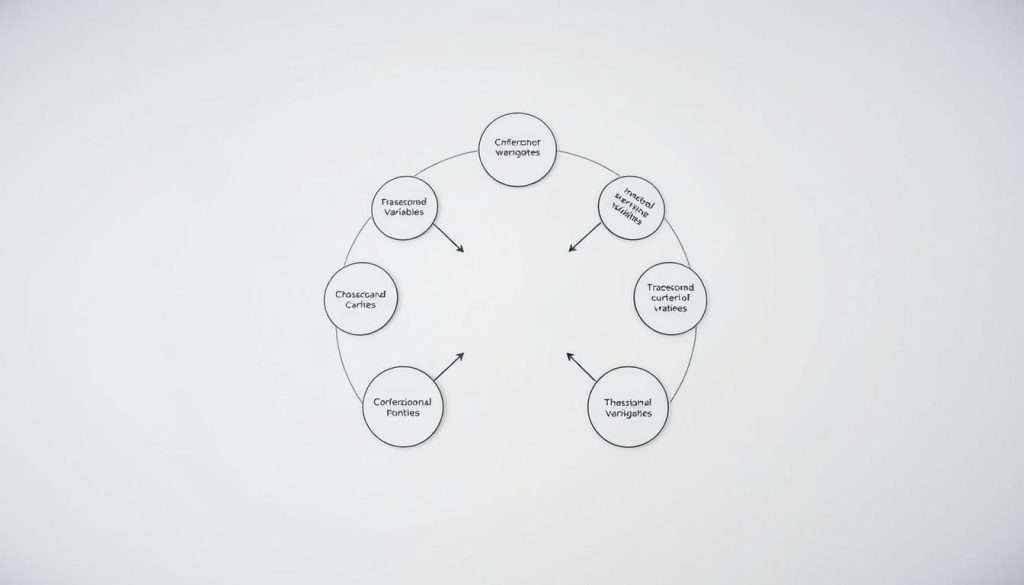We live in a world full of complex problems. These issues are all connected. To solve them, we must think in a holistic way.
By seeing how different parts work together, we can find good solutions.
So, what does it mean to think in systems? It’s about looking at how things relate to each other. It helps us spot patterns.
This way of thinking helps us make smart choices. It leads to positive changes.
Key Takeaways
- Understand the concept of systems thinking
- Learn to analyze complex problems holistically
- Develop effective solutions by recognizing patterns
- Make informed decisions with a deeper understanding of interconnected components
- Create positive change by adopting a systems thinking approach
What Is Systems Thinking and Why It Matters
Systems thinking helps us understand and solve complex problems. It looks at the whole system, its parts, and how they work together. This way, we don’t just focus on one thing alone.
Defining Systems Thinking in Today’s Complex World
Systems thinking shows how different parts of a system affect each other. In today’s world, this is key for solving big, connected problems. It lets us see the full picture and avoid surprises.
It’s about seeing the big picture and knowing we’re all connected. This view helps us deal with today’s big challenges, like the environment and social issues.
The Evolution of Systems Thinking
Systems thinking has grown over time, learning from biology, physics, and sociology. It started in the early 20th century, moving away from just looking at parts. Scientists wanted to see the whole system.
Now, systems thinking keeps getting better, using new methods and tools for today’s tough problems. This approach helps us find better ways to solve our world’s big issues.
The Fundamental Principles of Thinking in Systems
Systems thinking is powerful because of its basic principles. These principles show how complex systems are connected. By knowing these, we can better handle the world around us.
Interconnectedness: Everything Is Connected
At the core of systems thinking is the idea of interconnectedness. It says everything in a system is linked and depends on each other. For example, in an ecosystem, plants, animals, water, and soil are all connected. A change in one can affect the whole.
Seeing these connections helps us understand how systems work. Donella Meadows, a systems thinking expert, said, “Everything is connected. You can’t change one part without affecting the whole.”
Emergence: The Whole Is Greater Than the Sum of Its Parts
Emergence is another key principle. It shows how a system can have properties that are more than its parts. For example, a flock of birds flying together creates a pattern that’s hard to predict from individual birds.
This emergent property comes from how the parts interact and organize. Knowing about emergence lets us see the complexity and beauty of systems.
Feedback Loops: Understanding Circular Causality
Feedback loops are vital in systems thinking. They show how actions can either boost or balance each other in a system. A reinforcing feedback loop makes an action stronger, while a balancing loop counteracts it.
For example, in a climate system, melting Arctic ice lowers Earth’s albedo (reflectivity). This leads to more heat absorption and more ice melting—a reinforcing feedback loop. Knowing these loops is key to predicting and managing system behavior.
By understanding interconnectedness, emergence, and feedback loops, we can grasp complex systems better. This helps us navigate and influence them more effectively.
How Systems Thinking Transforms Problem-Solving
Systems thinking is a game-changer when solving problems. It helps us move beyond linear thinking and tackle the real-world complexities. This approach is key to finding lasting solutions.
Moving Beyond Linear Thinking
Traditional problem-solving often sticks to simple, linear solutions. But systems thinking shows us the interconnectedness of different parts in a system. This leads to more complete and effective answers.
Identifying Root Causes vs. Symptoms
Systems thinking is great at spotting the real problems, not just the symptoms. By understanding the system’s inner workings, we can fix the root cause. This way, we don’t just treat the symptoms.
5 Key Mental Models for Effective Systems Thinking
To understand complex systems, systems thinkers use various mental models. These models help clarify and provide insight into system dynamics. They are key for making informed decisions.
Causal Loop Diagrams
Causal loop diagrams are a basic mental model. They show how elements in a system affect each other. They reveal feedback loops that can either stabilize or destabilize the system.
How to Create Your First Causal Loop Diagram
To make a causal loop diagram, first identify your system’s key variables. Then, show how these variables interact with each other using arrows. Label the loops as reinforcing or balancing to see their system impact.

Stock and Flow Models
Stock and flow models are essential for understanding system dynamics. They distinguish between stocks (accumulations) and flows (rates of change). This model is great for analyzing systems where accumulation and depletion are important.
Iceberg Model
The iceberg model teaches us to look beyond surface-level events. It helps us explore the underlying structures and mental models that drive these events. It’s a powerful tool for finding the root causes of problems.
Leverage Points
Finding leverage points is crucial in systems thinking. These are areas where small changes can have big effects. Knowing where these points are helps in designing effective solutions.
Boundaries and Time Horizons
Understanding a system’s boundaries and time horizons is also vital. It involves defining what’s included and excluded from analysis and the time frame considered. This model helps avoid oversimplification.
By using these five mental models, you can improve your systems thinking. This makes you better at analyzing complex situations and finding effective solutions.
Developing Your Systems Thinking Mindset: A Step-by-Step Approach
To think in systems, we must first see the world as a complex network. This network is full of relationships and feedback loops. This change in view is not just about understanding systems. It’s about changing how we interact with the world.
Step 1: Observe the Whole Picture
Observing the whole picture means taking a step back. It’s about understanding the system’s broader context and connections. It’s seeing beyond the immediate details to grasp the larger dynamics.
Practical Techniques for Expanding Your Perspective
To expand your perspective, try using techniques like mapping or diagramming the system. Visualizing the components and their interrelations can help you understand the system’s structure and dynamics.
- Identify the key components of the system.
- Map the relationships between these components.
- Look for patterns and dynamics that emerge from these interactions.
Step 2: Identify Relationships and Patterns
Once you have a broad view of the system, the next step is to identify the relationships and patterns within it. This involves analyzing how different components interact and influence each other.
In a business context, understanding how different departments interact can reveal opportunities for improvement. As Peter Senge notes in his work on learning organizations, “The ability to see interdependencies is crucial for making informed decisions.”
Step 3: Recognize Feedback Loops
Feedback loops are critical in systems thinking as they reveal how actions and their consequences loop back to influence the system. Recognizing these loops helps in understanding the system’s behavior over time.
| Feedback Loop Type | Description | Example |
|---|---|---|
| Reinforcing | Amplifies the effect of a change | A marketing campaign that increases product visibility, leading to more sales. |
| Balancing | Counteracts a change to maintain equilibrium | A thermostat regulating room temperature. |
Step 4: Challenge Your Assumptions
Challenging your assumptions is a crucial step in developing a systems thinking mindset. It involves questioning your own understanding and being open to alternative perspectives.
“The most important thing in communication is hearing what isn’t said.” –
This quote highlights the importance of being aware of our own biases and assumptions. It’s about being open to learning from others.
Practical Exercises to Strengthen Your Systems Thinking Skills
Now that we’ve covered the basics of systems thinking, it’s time to try it out. These exercises are meant to help you use systems thinking in your daily life and solve big problems.
Exercise 1: Map Your Daily Systems
Begin by mapping a system you see every day, like your morning routine. Look at the parts, how they connect, and any feedback loops. For example, what happens when you hit the snooze button?
Example: Mapping Your Morning Routine as a System
Think of your morning routine as a system. It includes waking up, exercising, eating breakfast, and getting ready for work. Map out how these parts relate to each other. For instance, exercising might make breakfast more fun, but it could also make getting ready harder.
Exercise 2: Analyze a Current Event Through Systems Lens
Take a current event or issue and look at it through systems thinking. Find the key parts, how they connect, and any feedback loops. This shows how systems thinking can give you a deeper understanding of complex problems.
- Find the main parts of the system related to the event.
- Map out how these parts connect.
- Look for feedback loops that might be affecting the situation.
Exercise 3: Collaborative Systems Mapping
Do collaborative systems mapping with others. Pick a system to map together, like a community project or a workplace process. This shows how different views can help understand complex systems.
- Get a group of people with different perspectives.
- Pick a system to map together.
- Discuss and write down the parts, connections, and feedback loops together.
By doing these exercises, you’ll get better at thinking in systems. This will help you solve complex problems more effectively.
Applying Systems Thinking in Different Domains
Systems thinking helps solve problems in business, personal growth, and environmental issues. It looks at how different parts of a system work together. This way, you can make better decisions and create real change.
Systems Thinking in Business and Organizations
In business, systems thinking helps companies deal with complexity. It finds key areas to focus on and shows how decisions affect the whole system. This leads to better work flow, teamwork, and new ideas.
Case Study: How Company X Used Systems Thinking to Solve Complex Problems
Company X, a top manufacturer, had big supply chain problems. They used systems thinking to map their supply chain, find weak spots, and make it stronger. This move reduced risks and made them more competitive.
| Benefits | Actions Taken | Results |
|---|---|---|
| Improved Operational Efficiency | Supply Chain Mapping | Reduced Costs by 15% |
| Enhanced Collaboration | Cross-Functional Teams | Increased Innovation by 20% |
Systems Thinking for Personal Development
For personal growth, systems thinking helps see how daily actions affect long-term goals. It shows how habits and choices create patterns. This knowledge lets people make positive changes and grow.
Systems Thinking for Environmental and Social Challenges
Systems thinking is key for tackling big environmental and social problems. It helps understand how social, economic, and environmental systems are connected. This knowledge leads to better solutions for issues like climate change, inequality, and resource use.
Common Pitfalls in Systems Thinking and How to Avoid Them
When we explore systems thinking, it’s key to know the common traps. This approach helps us understand complex problems. Yet, it comes with its own set of challenges.
Oversimplification of Complex Systems
One major issue is oversimplifying complex systems. Making things simpler can help, but it can also miss important details. We should aim for a balance. This ensures we grasp the system’s key dynamics.
Analysis Paralysis
Analysis paralysis is another trap. It happens when we want to fully understand a system and do nothing. To dodge this, we must set limits and deadlines for our analysis. Knowing when “good enough” is enough is crucial.
Ignoring Human Factors
Systems thinking often overlooks human factors. Yet, people’s actions, motivations, and interactions are vital. Including these in our thinking leads to better, lasting solutions.
By knowing these pitfalls and how to sidestep them, we can fully use systems thinking for positive change.

Tools and Resources to Enhance Your Systems Thinking Practice
As you explore systems thinking, you’ll find many tools and resources. These can help you map complex systems and understand them better. They also make it easier to apply systems thinking in real life.
Software Tools for Systems Mapping
There are many software tools for systems mapping, like Lucidchart and STELLA Architect. They have features like causal loop diagrams and stock-and-flow modeling. This makes complex systems easier to see.
Lucidchart helps you make professional diagrams. STELLA Architect is great for simulating dynamic systems.
Books and Courses on Systems Thinking
To learn more about systems thinking, check out books like “Thinking in Systems” by Donella Meadows and “The Fifth Discipline” by Peter Senge. Online courses on Coursera and edX also offer structured learning. These resources give a deeper look into systems thinking.
Communities and Networks for Systems Thinkers
Joining communities and networks connects you with others who think like you. Look for online forums, local meetups, and professional organizations focused on systems thinking. Being part of these groups keeps you updated on the latest in systems thinking.
Conclusion: Embracing Systems Thinking as a Lifelong Practice
Today’s world is full of complex challenges. Adopting systems thinking can be a big help. It lets us see how everything is connected and work towards real change.
Systems thinking is all about learning and practicing every day. It makes us curious and open to new ideas. This way, we can better understand the systems we’re part of and move through them smoothly.
As you keep learning about systems thinking, remember it’s useful in many areas of life. It helps you tackle tough problems and make a difference. By using systems thinking, you’ll get better at solving complex issues and making things better.
We urge you to keep learning and using systems thinking every day. The more you do, the more you’ll see how everything is connected. And you’ll get better at making positive changes in the world.

